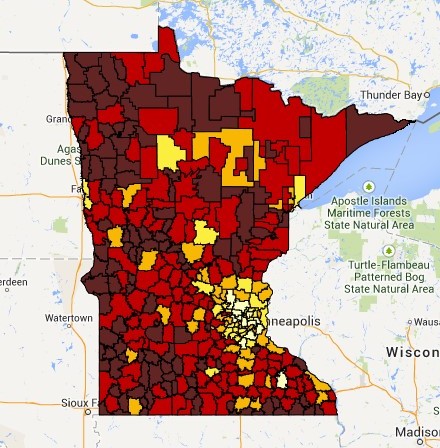By Sam Walseth, MREA Lobbyist
Two “dark of night” decisions created what looks like a glaring inequity in how much money school districts get.
School finance is complicated and it was made more so in 2011 with the creation of Small Schools Revenue (SSR) and in the 2013 bill with the creation of Location Equity Revenue (LER). The rational and parameters for each have raised eyebrows to say the least.
 In the wake of these two programs are 132 districts with 147,000 students in what we are lovingly referring to as the “donut hole.” School districts with 600-999 students would do better financially with the LER than what they get from SSR and those between 1000-1999 students, don’t get either SSR or LER. These are the donut hole districts. View a map MREA created showing the donut hole.
In the wake of these two programs are 132 districts with 147,000 students in what we are lovingly referring to as the “donut hole.” School districts with 600-999 students would do better financially with the LER than what they get from SSR and those between 1000-1999 students, don’t get either SSR or LER. These are the donut hole districts. View a map MREA created showing the donut hole.
They weren’t singled out for a particular reason. They just were singled in for particular legislative action. With SSR and LER book-ending the system, those in the donut hole are asking ‘what about us?’
‘What about us?’
One key distinction to remember is that “revenue” can be comprised of state aid and local levy dollars or some combination of both. SSR is completely state aid and spends about $16 million each year. LER is almost all levy derived from the Referendum Market Value (RMV) tax base. LER is equalized and the small amount of equalization aid associated with the program will go to the rural districts that qualify should those local boards remain in the program.
Greater Minnesota districts with more than 2,000 kids qualify for LER and they needed to vote by Aug. 31 to opt out of LER if they didn’t want to participate.
LER is basically a swap of already existing voter approved RMV dollars, especially for metro area districts that tend to have large amounts of referendum authority. A few Greater Minnesota districts were in a position to generate new, mostly levy dollars from the LER program.
Equity
There is a big question about financial equity in the system if the impact of LER on districts at the referendum cap will be able to create space underneath the cap by converting referendum authority to LER. This could exacerbate funding inequities over time as metro districts seem more readily able to increase referendum authority where as rural districts seem much more property tax averse for a variety of reasons.
However, the question donut hole districts are asking is: What is the state going to do for them to eliminate this eyesore in the funding system?
Filling the Hole
Finding state aid for the donut hole along the lines of an expanded SSR program would cost the state tens of millions of dollars each year that it doesn’t have today. Extending the LER levy option to those in the donut hole would cost the state a fraction of that, but DFLers heading into an election year will be reluctant to vote for more property tax authority for schools when they’re trying to argue they reduced or froze property taxes. GOP members are traditionally opposed to the idea of letting school boards levy operating dollars without a public vote.
We wonder too, how many rural districts are looking for additional levy authority in the wake of the new board authority to set the first $300/pupil levy on RMV.
Filling in the donut hole will require thoughtful consideration by school officials and a delicate conversation with legislators. Keep in mind many of those legislators just stuck their necks out to raise revenue for education programs we have long asked them to pay for, including all day K. MREA looks forward to tackling this next stage in the battle for equity in the school funding system.

